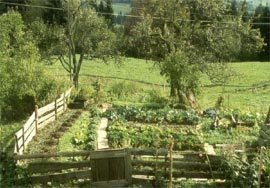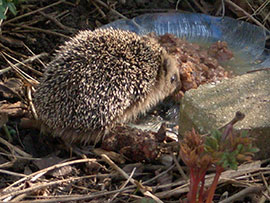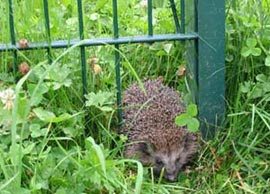A naturally designed garden provides hedgehogs with invertebrates to eat and places to shelter and nest. The garden can very easily be made into an attractive haven for many small animals and by not cleaning up too thoroughly, it can be maintained as habitat for Hedgehog and Co.

Pesticides and weedkillers kill insects, they destroy the hedgehog’s food sources. When “pests” get out of hand, they should be controlled exclusively by organic means. Do not use artificial fertilizers! Do not use artificial fertilizers! Compost soil, bark mulch and other natural fertilizers do the same job and don’t harm animals.
Hedgehogs find insects and especially earthworms in short grass. Blooming and seeding grasses and flowers are not only important to insects. So leave the edges of the garden under bushes and hedges and only mow them, best of all never, but at most twice a year – after careful inspection.
Not only are they better adapted to our soil and climate, they are also indispensable to a great variety of insects, birds, and small mammals like the hedgehog. Exotic plants are sterile and of no use to our indigenous fauna.
A small garden pond with shallow banks can save hedgehogs from dying of thirst – especially in dry summers. Flat and steady dishes filled daily with fresh water, serve the same purpose.
Whether or not a hedgehog has visited a (hedgehog friendly) garden, can be seen by looking for his calling cards. The droppings of a healthy hedgehog consist of little dark brown/black sausages about 3 – 6 cm long.

The natural food of the nocturnal hedgehog is also nocturnal insects – there is no shortage of them! Look at the world with hedgehog eyes, not with human eyes!
Only in an absolute emergency situation is the feeding of individual animals, limited in time and quantity, sensible. By setting up an evening feeding station in late autumn it may be unnecessary to take underweight hedgehogs into human care. This means evening supplementary feeding for a maximum of three weeks with food appropriate to the species. The daily amount of food should not exceed 10% of the body mass, this means for a medium sized hedgehog a maximum of 2-3 tablespoons or the amount which fills a small 150g yoghurt pot. Hedgehogs need a varied food supply!
To protect the food from other animals and the weather, place it in the evening, for example, in a small box provided with at least two 10 x 10 cm small entrance holes. The feeding place must always be kept clean to prevent the hedgehogs from infecting each other. The feeding dishes should be cleaned thoroughly every day, preferably placed on newspaper, which should be changed every day.
From the onset of winter at the latest, you must stop feeding immediately so as not to keep the hedgehogs artificially awake. Lack of food is an important trigger for hibernation.
Natural garden design is the best way to help hedgehogs. You can also offer artificial nest boxes as sites for day nests and hibernation.
Hedgehog houses can be home made or obtained from specialist shops, pet shops, garden centres and a few workshops as well as some regional hedgehog conservation societies. Read more about Hedgehog houses.





